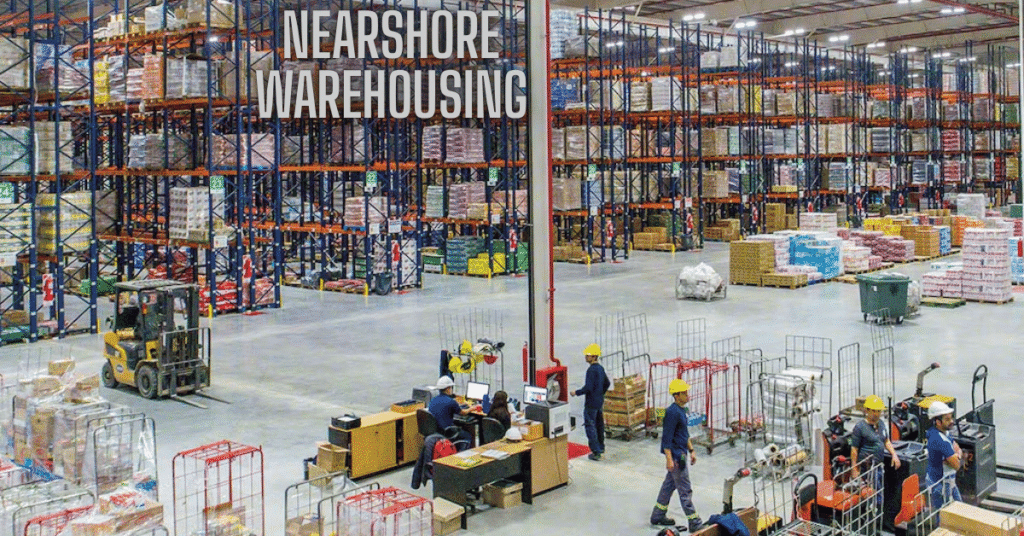Introduction
Amid the ongoing economic turmoil, businesses today are operating in an environment that has practically vacuum-sealed customer value more quickly than at any other time in history-in a truly turbulent world economy. Yet-it is very hot; there are, however, hot concepts beginning to take some attention lately-nearshoring is perhaps one of the hottest debated topics. This, nearshoring, is changing the entire paradigm in warehousing, order-processing, and customer satisfaction from a logistics viewpoint.
Integrating and utilizing inherent advantages from nearshore warehousing-whether for e-commerce, manufacturing, or distribution-could undeniably provide a long-term view. As such, this paper strives to state the idea of nearshore warehousing, its relative merits, potential challenges in implementation, and how to render it sustainable so that such early conceptualizations of supply-chain processes may influence action choices to an extent.
What Is Nearshore Warehousing?
Those warehouses complementing either borders or outside that have any oceanic link with the company’s land are known as nearshore. It includes the so-called nearshore manufacturing, which brings the indirect meaning of the product being manufactured near or directly next to the major market.
In other words, this means that instead of keeping inventory in a country thousands of miles away, such as China or Vietnam, a US company would keep stock in Mexico or Canada. Geographically, closer in terms of actual fast shipping without the burden of different time zones, cultural differences, and customs regulations.
Major Benefits of Nearshore Warehousing
1. Shortened Delivery Time
The closer the stocks are to the clients, the faster an order can be matched with fulfillment, which implies reduced lead time, coupled with increased possibilities of developing a rapid-response option from somewhere nearshore with the feeling of pseudo-e-cost.
2. The Transportation-Revenue Added
Lower transport cost as compared to transporting it from a far-off country. Such would easily help in improving the margin in consumer pricing.
3. Greater Supply Resolution Resilience
The upheavals of events such as COVID-19 or the blockage of the Suez Canal exposed the vulnerability of what has been termed as traditional supply chains. There are no nearshore warehouses that buffer against probable disruption in customer support, decoupling from long-haul international routes.
4. Improving Management Inventory
Best forecasted demand into close storage: your customers will be stock-rich inventory, followed by replenishments in due time, where the production process does not have exposure to both further stocking and stock-out risks.
Meanwhile, communication and control over such countries become easier to maintain.
Compared to Onshore-Offshore Warehousing, according to Geographical Criterion-Onshore Nearshore Offshoring-In-Country-Adjoining Country-Far Away Country, Transportation Time-Fast-Moderate Slow Cost Efficiency-Higher-Balanced-Lower cost but high shipping, Supply Chains, Risk—Low-Moderate High, Communications—Easier—Relatively Easy—Often Difficult
Industries with favorable opportunities in nearshoring:
- E-commerce and retail Speed becomes critical in the retail business, thus nearshore becomes attractive for dedicated same- or next-day delivery services.
- Automotive-This sector has very strong JIT dependence. With nearshore warehousing, we now push the components flow more effectively closer to the assembly halls.
- Medical and health industries-Delivery on time, rigorous business practices, and accuracy demands. Nearshore warehousing can secure and strengthen the distribution for pharmaceuticals and medical devices.
- Consumer Electronics- Fast-moving consumer goods become highly competitive with their very short product life cycle by taking advantage of nearshore warehousing.
Strategic nearshore location of warehouses
Strategically, having a foundation to shape your nearshores is very critical. The following are some of those foreign territories that can be used in the consideration:
- Mexico: In terms of one free trade agreement-most especially USMCA and highly skilled labor, this is the best proximity to be around for the U.S. firms.
- Canada: Advanced infrastructure, ease of doing business, and market familiarity.
- Eastern Europe By western European companies: Poland, Hungary, and Romania top the charts with respect to superior infrastructure and low tariff barriers.
Southeast Asia for the regional distribution-bringing nearer shores for companies, either Japan or Australia-based based includes such Southeast Asian countries like Thailand and Malaysia.
Oh, the Nearshore Warehouse is an Evil, Dark Place in Hell: A few of the caveats of nearshore warehouses, together with the advantages.
1. Customs & Tariffs
- Though applicable, nearshoring might greatly smooth customs checks, import duties, or export duties.
2. Infrastructure Limitations
- Not every nearshoring space has the infrastructure to support high-volume tech-driven warehousing operations.
3. Regulatory Compliance
- Every country has its laws in place. Therefore, companies must ensure compliance with tax codes, labor laws, and safety standards.
4. Start-Up Costs
- Nearshore warehouse start-up costs are expensive establishment costs such as logistics partners, space, and tech.
Implementing Nearshore Warehousing
For the nearshore warehouse to be set up and operated, proper planning and implementation need to occur. The general stages of the process would be:
Step 1: Determine Business Needs
Time should be taken to analyze the pain points in the supply chain. Are delays in delivery related to customer satisfaction? Does demand misalign with inventory?
Step 2: Select Strategic Location
Choose a country close to your primary market, with trade agreements favorable to you, and with a good climate for business.
Step 3: Train your Teams
Cross-border logistics training of personnel and partners to mitigate compliance risk should be carried out.
A Real-Life Example of Nearshore Warehousing
Bear the example of a U.S. fashion brand moving its warehouse from China to Mexico. Historically, near-shore warehousing problems were:
- Long delivery times-3 to 4 weeks.
- High shipping costs.
- Losing income due to stock-outs.
With a Tijuana Near-shore warehouse established:
- Shipping to the U.S. became a 2-3 day delivery.
- Based on demand forecasting, the inventory would be set.
- Sales increased by 20% as a result of rapid fulfillment.
- All factors enhanced customer satisfaction while saving on costs by 18%.
Near Future for Nearshore Warehousing
This warehousing phenomenon will trend incredibly fast with industries in need of agility, cost-efficient, and resilient scaling for their future productions. Automation, AI forecasting, and Blockchain will add deep transparency and efficiency to the already poorly forged nearshore supply chains.
Nearshoring warehouses would also get global consideration in the creation of next-generation logistics strategies, considering the trends that global trade would continue to embrace with a myriad of challenging scenarios, among them geopolitical events, environmental implications, as well as consumer preferences.
Conclusion
Nearshore warehousing is a highly compelling solution for obstinately modern enterprises that struggle to find a balance between cost and operational flexibility. The pulling of inventory close to core markets enables firms to raise service levels while diminishing transport costs. This, in unison, makes the supply chain much more resilient.
However, the transition into a near-short warehouse will, in most cases, require deliberation and investment and, hence, would hardly ever yield returns fast. Some of the sectors where nearshore could be most lucrative include e-commerce, retail, automotive, and healthcare.
The time has come for a more thorough investigation of the nearshore warehousing option as an integral element of any global logistics architecture.
FAQs About Nearshore Warehousing
Q1: What’s the difference between nearshore and offshore warehousing?
Nearshore warehousing involves putting inventory in countries nearby to you, whereby shorter shipping times and costs contrast with offshore warehousing, in which products are stored in far-away locations.
Q2: Is nearshore warehousing only beneficial to U.S. businesses?
Not at all. Generally, almost any company that has the products placed in bordering or nearby countries-from Europe to Asia-will enjoy some benefits from nearshore warehousing.
Q3: What factors do I consider in choosing the best nearshore location?
A few of the things to consider include proximity to market, trade agreements, infrastructure, regulators, availability of labor, and so forth.
Q4: Does nearshore warehousing apply to small businesses?
Absolutely! Many 3PLs provide flexible warehousing solutions that make nearshore warehousing feasible for small and medium-sized enterprises.
Q5: Is nearshore warehousing green?
Perhaps. Since nearshore warehousing will considerably reduce the distance goods travel, it thus helps in lowering carbon emissions through long-distance transportation.
Q6: What are the major risks in nearshore warehousing?
Those are regulatory complexity, initial investment, and trust in third-party associates.
Q7: How quickly can I set up a nearshore warehouse?
Depending on your supply chain needs, this could take from a few weeks to a couple of months, together with a reputable 3PL partner.



